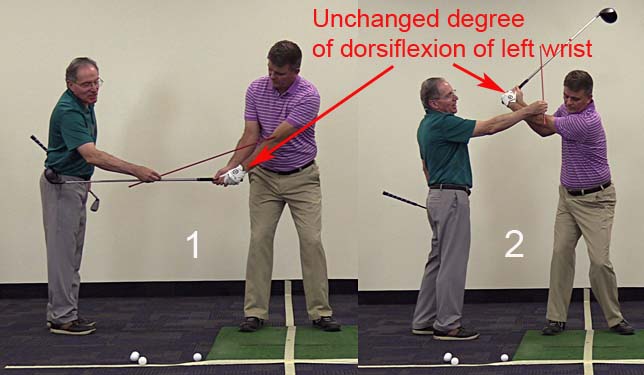
Discussion of unchanging left wrist angle when the LAFW moves in space
Click here to go back to the video project's
index page.
Starting at the 46 minute time point of part 1 of my video project, I
demonstrated how the LAFW moves in space (flies in space) during the backswing
and downswing and also during the early followthrough (to at least the P7.2
position), and I stated that the "angles do not change". It is important to
understand that I am referring to the wrist angle at the back of the left wrist
(reflected by the degree of left wrist dorsiflexion), and if that dorsiflexion
angle doesn't change in magnitude, then the LAFW remains intact and I still have
a GFLW. Note that I am not referring to the left wrist angle in
the plane of radial-ulnar deviation, because that angle is in the plane
of the LAFW and any change in that angle doesn't disrupt the intact
LAFW. During the backswing, the left wrist upcocks (radially deviates), and
during the downswing the left wrist uncocks (ulnar deviates), thereby changing
the left wrist angle in the plane of radial-ulnar deviation. However, those
changing wrist angles in the plane of radial-ulnar deviation to not disrupt an
intact LAFW/GFLW alignment because they are happening in the plane of an intact
LAFW.
Capture images from the part 1 video.

Image 1 is at the P2 position and image 2 is just past the P3 position. Note
that there is no change in the degree of left wrist dorsiflexion - even though
the left wrist is more upcocked (radially deviated) in image 2 (relative to
image 1) which means that the LAFW is still intact (and the clubshaft is still
straight-line-aligned with the straight left arm).
I have added this clarification because I was concerned that some viewers of the video may have misunderstood what I meant when I stated in the part 1 video that the "left wrist angle" remains unchanged.
Jeffrey Mann.
January 2017.